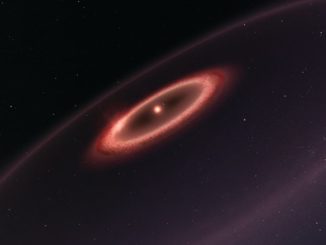
Astronomers using the Atacama Large Millimeter/submillimeter Array, or ALMA, have found a gravitationally lensed galaxy shining just 1.4 billion years after the Big Bang that features a central bulge similar to those found in nearby galaxies. The remote galaxy appears surprisingly unchaotic and evolved in contradiction to current ideas about how galaxies formed in the early universe.
“This result represents a breakthrough in the field of galaxy formation, showing that the structures that we observe in nearby spiral galaxies and in our Milky Way were already in place 12 billion years ago,” said Francesca Rizzo, a Ph.D. student at the Max Planck Institute for Astrophysics who led the research.
The galaxy, known as SPT0418-47, appears as a “ring of fire” as its light is gravitationally bent around an intervening galaxy, magnifying features that otherwise could not be seen. Because of the near-perfect alignment, researchers were able to deconstruct the image to discern the remote galaxy’s shape and the movement of gas within it.
The European Southern Observatory, a partner in ALMA, provided a video illustrating the analysis (credit: ALMA (NRAO/ESO/NAOJ)/Martin Kornmesser (ESO)):
While the researchers saw no obvious evidence for spiral arms, they were surprised to find two features typical of galaxies like the Milky Way: a rotating disc and a central bulge made up of close-packed stars. It is the most distant, and thus oldest, galaxy yet found with such clearly defined features.
“The big surprise was to find that this galaxy is actually quite similar to nearby galaxies, contrary to all expectations from the models and previous, less detailed, observations,” said co-author Filippo Fraternali of the Kapteyn Astronomical Institute, University of Groningen in the Netherlands.
Galaxies forming in the aftermath of the Big Bang were generally thought to have been chaotic structures due to the effects of galactic mergers and frequent supernova blasts, resulting in “dynamically hot, chaotic and strongly unstable” structures, the team writes.
“What we found was quite puzzling. Despite forming stars at a high rate, and therefore being the site of highly energetic processes, SPT0418-47 is the most well-ordered galaxy disc ever observed in the early universe,” said co-author Simona Vegetti, also from the Max Planck Institute for Astrophysics. “This result is quite unexpected and has important implications for how we think galaxies evolve.”
The research was published 12 August in the journal Nature.



